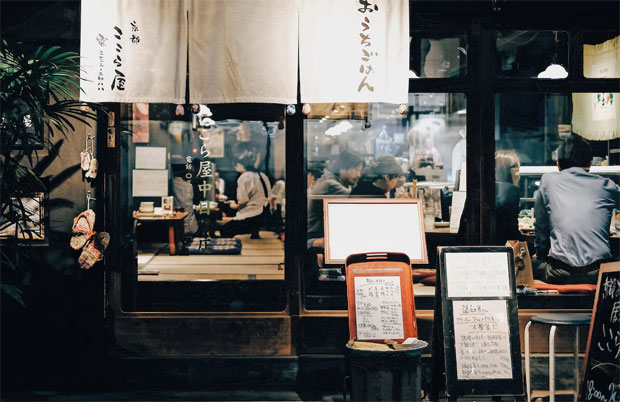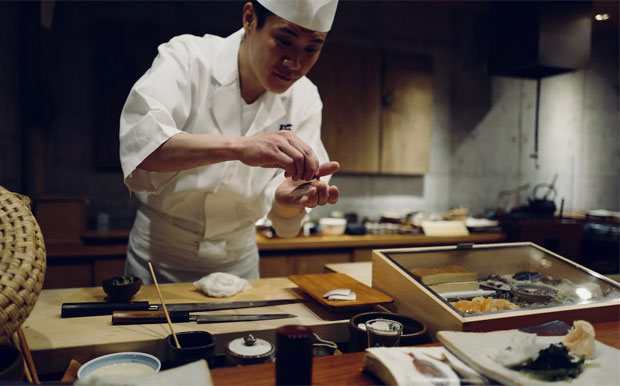The Basics of Serving Dishes a Japanese Way + Japanese Dining Etiquette

The Basics of Serving Dishes a Japanese Way + Japanese Dining Etiquette
If you stay in a Japanese hotel and are going to have breakfast, but do not know how to properly place on the tray dishes that you take from the buffet table, it is useful to remember a few rules.
The basic principle of Japanese cuisine is one soup and three dishes – that is, you need to choose miso soup or other soup, rice and two sides. This is easy, but not everyone remembers how to place cups and plates on the tray in the right order.

Serving Japanese food is very rational. You can, of course, do without this knowledge, but if you remember it, you immediately understand the meaning of placement.
- The chopsticks are placed in the right hand and the rice is placed in the left so that you can pick up the bowl of rice in the left hand without making any movements.
- A cup of hot soup is placed on your side so that it can be easily taken. Because on the left is a bowl of rice, the soup is on the right.
- The main course is on the far right. Since the dish with the main dish in it is usually not held, it can be reached with chopsticks that are held in the right hand.
- Stewed nimono (a simmered dish) or other side dishes can be found on the left in the lower part.
- Aemono (dressed foods in a salad dressing or a sauce) and ohitashi (side dish of blanched greens in a soy-based marinade ) are located in the centre of the tray on the left side.
- Pickles are mono-no (they go beyond the principle of one soup and three dishes) and put in a free place – for example, between rice and soup.
Tea or water is placed on the right side where it is easier to take a cup in your hand.

How to Properly Eat Whole Fish
Place the whole fish on your plate so that the head is left and the tail is right. According to one theory, rice is traditionally placed on the left side and fish are placed on the left side with their head because of the ancient Japanese notion of left-wing supremacy – for example, the Left Minister at the court was higher than the Right. However, first of all, it is important that the fish located this way is more convenient to eat, using the right hand.
The fish begins to be separated from behind their heads, moving towards their tails. It is considered bad form to turn the fish after eating its upper half – you should use chopsticks to remove the bones, hold the head slightly with your left hand, and then eat the remaining half. After eating, the spine, head and tail lay neatly on the far side of the plate.
By the way, fillets of salmon, coalfish (gindara, silver cod) and other fish are usually served, placing the broad side on the left, and the skin on the far side.

Japanese Dining Etiquette
- The older the person, the smaller the portion offered, also in summer the amount of food on the plate is less than in winter.
- The size of the table is usually such that it was convenient to eat a dish with chopsticks. The tables are usually lacquered, and dark in colour.
- Before you start the meal, all people present are given a warm and slightly wet towel, which is called Oshibori. It is necessary to wipe your hands before eating to ensure that they are clean.
- In Japan, as in many other countries, it is customary to wish bon appetite (which is itadakimasu in Japanese!) – but with one important difference. The people of Japan say this wish before each new dish is served whatever it would be – sashimi or tempura.
- At the end of the meal, it is best to put the chopsticks on the edge of the plate, in parallel but not across each other.
- First, you fill the bowl of a neighbour at the table and then expect the same from him.
- Chewing, chirping, eating noodles with whistle and noise – it is common for a Japanese not only at home at the family table, but also in a restaurant. This is a kind of praise to the chef, a sign that the dish is a success!
- In Japan rice is given a lot of respect, so they eat it to the last grain.
- In Japan, the Land of the Rising Sun, it is not customary to leave tips, on the contrary, it will offend the waiter, so please remember that when dining out in Japan or in Japanese restaurants.
| Guest Article. |




